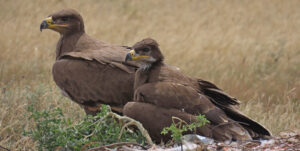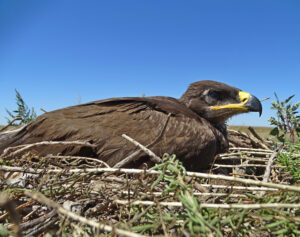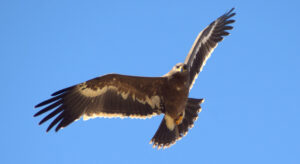Third International Scientific and Practical Conference “Eagles of the Palearctic: Study and Conservation”
Raptors Conservation. Suppl. 2. Proceedings of Conferences
Steppe Eagles in Bokey-Orda Nature Reserve and Ashiozek Sanctuary (Western Kazakhstan Region) in 2022–2023
Smelansky I. E. (Association for the Conservation of Biodiversity in Kazakhstan, Astana, Kazakhstan)
Tomilenko A.A., Barashkova A.N. (Sibecocenter LLC., Novosibirsk, Russia)
Aleksandrovich R.N., Kitibaev B., Koshkina A. (Association for the Conservation of Biodiversity in Kazakhstan, Astana, Kazakhstan)
Contact:
Ilya Smelansky ilya.smelansky@acbk.kz
Andrey Tomilenko aatom@ngs.ru
Anna Barashkova yazula.manul@gmail.com
Roman Alexandrovich roman.alexandrovich@acbk.kz
Beibars Kitibaev kitibaev.b.d@gmail.com
Alyona Koshkina alyona.koshkina@acbk.kz
Recommended citation: Smelansky I.E., Tomilenko A.A., Barashkova A.N., Aleksandrovich R.N., Kitibaev B., Koshkina A. Steppe Eagles in Bokey-Orda Nature Reserve and Ashiozek Sanctuary (Western Kazakhstan Region) in 2022–2023. – Raptors Conservation. 2023. S2: 253–258. DOI: 10.19074/1814-8654-2023-2-253-258 URL: http://rrrcn.ru/en/archives/35053
Steppe Eagle (Aquila nipalensis) is a typical and representative inhabitant of the steppe, a key predator in steppe ecosystems, and until recently the most common and abundant of Kazakhstan’s large raptors. In the last two decades, its abundance and range here have been greatly reduced. The species’ nesting group in the Volga-Ural interfluve has been little studied in the last 15 years.
The Bokey-Orda State Nature Reserve (SNR) and the Ashiozek Zoological Sanctuary were established in the western part of Western Kazakhstan Oblast in 2022. Together, they encompass the almost completely endorheic basin of the Ashiozek River along with its tributary water bodies – a complex of the salt lakes Aralsor, Batpak, Zhalpak, and Araltobe and a number of smaller such lakes. This vast (6,570 km2) territory contains desertified and dry steppes and northern halophyte and hemihalophyte deserts. The main objective for establishing these protected areas is to protect the saiga population and that ungulate’s habitats. The steppe eagle is also recognized as a priority conservation target. Additionally, the IBA “Lower reaches of the Ashchyozek River” is located within this region, an area identified on the basis of its importance for the Steppe Eagle.
Study of the nesting group started in 2022 and continued in 2023 in the framework of a long-term partnership between Association for the Conservation of Biodiversity in Kazakhstan (ACBK) and BokeyOrda SNR. The main research occurred June 28–July 8, 2022 (11 days) and June 26–July 11, 2023 (14 days) during the mass dispersal period for young offspring. The team’s expedition routes during the indicated periods was approximately 700 km in 2022 and 1,000 km in 2023. Two census sites were identified – Ashiozek (1,190 km2), and Aralsor-Araltobe (2,440 km2 ). In 2022, the Aralsor and Araltobe sites were analyzed separately). In 2023, roughly 25% of the Ashiozek site and about 30% of the Aralsor-Araltobe site were examined.
In 2022, 47 Steppe Eagle nests were found, including 19 active nests (40.5%), and 17 successful nests at the time of the survey (36%). At least 38 nesting sites were confirmed, 34 of which are occupied, and including at least 17 successful nests. The average nesting density for the entire surveyed area was approximately 4.75 nesting sites per 100 km2, including 4.2 occupied sites, and 2.1 successful sites per 100 km2. The average distance between nearest neighboring residential nests was 3.77±1.40 km (n=24), varying by registration sites from 2.92±1.06 km (n=11) at Araltobe to 4.40±1.35 km (n=8) at Ashiozek and 4.96±1.40 km (n=4) at Aralsor.
Brood size averaged 1.69±0.79 chicks per successful nest (n=16). It is likely that this indicator is underestimated: underestimation of the numbers of older chicks that have already fledged is possible for some broods. There is a characteristically sharp difference in the indicator between the Aralsor-Araltobe and Ashiozek sites: 1 (n=4) and 1.25±0.5 (n=4) and respectively, Aralsor and Araltobe, but 2.29±0.76 chicks (n=7) – Ashiozek.
In 2023, 110 Steppe Eagle nests were examined, 34 of which were active (31%), including 24 nests with successful breeding (22%) and six to ten nests with unsuccessful breeding (in four cases it was either impossible to determine breeding success or the nest had already been abandoned by fledglings), the rest were empty, but some of them (22 nests or 20% of the total) are visited by birds and used as perches.
That study includes the verification of 32 nests first identified in 2022. Of these in 2023, there were five active nests, four of which were successful and one presumably successful (almost all retained the same status as they had the previous year). Six nests that were successful last year turned out to be unoccupied in 2023 or were used only as perches. Two nests disappeared between visits (one of them burned in a fire).
85 adult Steppe Eagles were encountered, mostly in connection with nesting sites. 32 nestlings and fledglings (in their first days after leaving the nest) were identified in or associated with nests. 32 underyearlings (chicks and fledglings in the first days after fledging) were counted on nests or in connection with them. As in the previous year, by July 4–5 many fledglings without a clear connection to nests appeared in the area. Such birds often concentrate near water bodies (ponds, collection basins, deep river areas). 56 such fledglings were documented. Three nests (all successful) contained a single undeveloped egg.
Surveyed nests containe one to two chicks and in just one case, three chicks. There were 1.90±1.51 chicks per successful nest (n=23) on average. As in 2022, this figure is probably underestimated. A distinct difference between the plots remained: 1.36±0.63 chicks (n=14) at Araltobe-Aralsor and 2.45±1.91 chicks (n=9) at Ashiozek.
A group led by Corresponding Member A.A. Chibilev assessed three nests at the Araltobe site on April 20, 2023. At that time of study, all three were occupied by brooding females: one nest contained two eggs and two nests contained three eggs each. When visited again in July, the nest with two eggs now contained two chicks (fledglings), one of the three-egg nests contained one chick (apparently attacked by a fox shortly before our visit), and the other three-egg nest was found empty, leaving no trace of reproduction.
The relative density of little ground squirrel burrows was determined on 53 transects to assess the eagles’ prey base. Evidence of Ground Squirrel colonies were found on more than 90% of the transects, but more than half of the marked settlements were non-residential. It seems that given the absence of optimal prey (little ground squirrel), the main available food source for the Steppe Eagle nesting group under study is Saiga Antelope carcasses, now plentiful in the steppe. Saiga limb remains were the most common type of fodder in the nest. It was also noted that eagles seem to feed only on fresh carcasses. The connection between the Steppe Eagle and the Saiga is further evident in that winter saiga fur was being used as a nest liner in the vast majority of examined nests, and Saiga bones were often used as material for nest construction.
In both years, Steppe Eagle food availability and nesting success at the AralsorAraltobe site are apparently lower than at Ashiozek.
Despite the creation of protected areas, bird-hazardous powerlines remain a significant deadly threats to eagles in the territory. A random check of power lines (sections of 2.5 km and 3.5 km) in suitable biotopes within the reserve contained on average more than one dead Steppe Eagle per one kilometer of power line. All eagle remains discovered correspond to a time of death in early spring or autumn, during the seasonal migration period.



